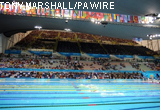 John Davies is a consultant anaesthetist in Lancaster, who takes part in motorsport as a competitor and as a rally doctor. He is volunteering as part of the Olympic games medical team in the aquatic centre. Over the next couple of weeks he will be blogging from the Olympic Park about his experience during the Olympic games.
John Davies is a consultant anaesthetist in Lancaster, who takes part in motorsport as a competitor and as a rally doctor. He is volunteering as part of the Olympic games medical team in the aquatic centre. Over the next couple of weeks he will be blogging from the Olympic Park about his experience during the Olympic games.
How are the Olympic medical team volunteers ready to help out at the Olympic Games? From our experience of critical care in many forms, we are already familiar with the standard resuscitation, trauma, and care life support and damage limitation techniques that might be needed to deal with acute injury or illness. We have been given equipment packed into two large back packs, scoop and basket stretchers, and all that would be required in an emergency.
Some is standard stuff—syringes, needles, airway equipment. And some is state of the art equipment led by recent military advances—combat tourniquets, chitosan-impregnated gauze, and dressings that have been so successful in Afghanistan to arrest apparently catastrophic bleeding.
We have practised working in the unfamiliar surroundings of the London 2012 aquatic centre, where a casualty could be on dry land, in the water, or even 10 metres high up on the a diving board. The latter proved to be especially difficult, not due to the height, but because of the narrow, steep staircases that lead up to the boards.
However, with our colleagues in the London Ambulance Service, which is also in attendance, we have evolved a technique that will work, using the light, narrow aquaboard —a spine board that is light enough to float— additional straps and stabilisation, and changing the two bearers at each stage of the descent. More standard, but not familiar to many of us, is a casualty in the water.
Our other colleagues are the lifeguards who are poolside and ready to go in at any moment. They will also use the aquaboard and like other board has fixed straps to bind the casualty firmly to the board, but also a head fixation device of triangulated straps that will stabilise the head, as efficiently, but differently to a spinal collar.
